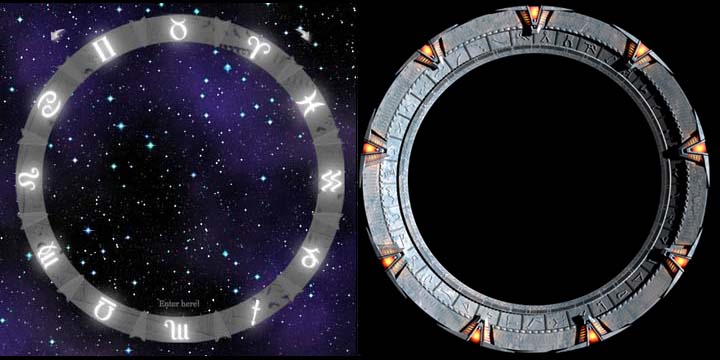Many will note the similarity between the Sphinx Stargate portal idea and the stargate concept from the 1994 science fiction movie Stargate, an idea continued in the later television series named Stargate SG1. As explained in the historical analysis, the Sphinx Stargate idea, which was originated by myself, actually preceded the appearance of the Stargate movie and may even have formed the basis for the stargate concept that appeared in the movie. Nevertheless, there are some differences between the two concepts that should be pointed out. First, we find that both stargates are associated with ancient Egypt, in particular with the Giza archaeological site. The Sphinx Stargate makes reference to the Great Sphinx of Giza and its metaphorical breast portal, whereas the stargate presented in the fictional movie Stargate is an ancient stone artifact that is unearthed from the sands of Giza in the early 20th century.
Both stargates utilize a series of constellations that revolve relative to a pointer or a set of pointers. But, whereas the Sphinx Stargate zodiac wheel has 12 constellation glyphs spaced around its circumference designating the 12 zodiac signs familiar to us from astrology (left image above), the movie’s stargate (right image above) instead has 36 alien/Egyptian hieroglyphs distributed around its circumference which are said to signify certain alien named constellations.
“Unlocking” either stargate requires alternate clockwise and counterclockwise rotations that sequentially select constellation symbols much like a pointer selecting numbers on the revolving dial of a safe’s combination lock. In the case of the Sphinx Stargate, the purpose of this sign sequencing is to decipher the zodiac cryptogram by reordering the zodiac signs into a new order that properly depicts its encoded physics of cosmic creation. In fact you may try your luck at deciphering it by going to our Riddle of the Sphinx page. The sphinx is a principle key to unlocking this zodiac sequence. As mentioned in our discussion of the Aker sphinx, in ancient times, aspirants to the Osirian mysteries who sought to learn the secrets of the science of cosmic creation, were led blindfolded before the Great Sphinx and upon venturing forward believed they had passed through its breast portal into a subterranean abode symbolizing the higher dimensional etheric realm. The stargate in the movie and SG1 TV series, though, operates much more literally. There, an inner constellation ring rotates relative to an outer set of pointers on the ring’s circumference, moving alternately clockwise and counterclockwise, the purpose being to activate the gate’s central wormhole portal which allows travelers to physically pass to another star system, galaxy, or parallel universe where they exit the wormhole by passing through a partner stargate located at the travel destination. The Sphinx Stargate involves no such physical teleportation journey. The initiate’s passage to its higher dimensional realm is a figurative journey, a journey of mind and not of body; it is reminiscent of the transformational trek that Dave takes when he encounters the stargate monolith in Arthur C. Clarke’s 2001: A Space Odyssey.
Paul LaViolette
May 2013
